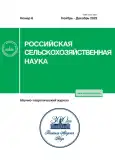Совершенствование процесса дозирования ультрадисперсных частиц при вибрационно- электромеханическом смешивании
- Авторы: Шахов В.А.1, Пушко В.А.1, Бойко И.Г.1, Герасименко В.В.1, Учкин П.Г.1, Попов И.В.1
-
Учреждения:
- Оренбургский государственный аграрный университет
- Выпуск: № 6 (2023)
- Страницы: 67-71
- Раздел: Статьи
- URL: https://journals.rcsi.science/2500-2627/article/view/233884
- DOI: https://doi.org/10.31857/S2500262723060145
- EDN: https://elibrary.ru/NIXIRM
- ID: 233884
Цитировать
Полный текст
Аннотация
Ключевые слова
Об авторах
В. А. Шахов
Оренбургский государственный аграрный университет
Email: shahov-v@yandex.ru
460014, Оренбург, ул. Челюскинцев, 18
В. А. Пушко
Оренбургский государственный аграрный университет460014, Оренбург, ул. Челюскинцев, 18
И. Г. Бойко
Оренбургский государственный аграрный университет460014, Оренбург, ул. Челюскинцев, 18
В. В. Герасименко
Оренбургский государственный аграрный университет460014, Оренбург, ул. Челюскинцев, 18
П. Г. Учкин
Оренбургский государственный аграрный университет460014, Оренбург, ул. Челюскинцев, 18
И. В. Попов
Оренбургский государственный аграрный университет460014, Оренбург, ул. Челюскинцев, 18
Список литературы
- Сыроватка В.И., Жданова Н.В., Обухов А.Д. Исследование кинетики движения ингредиентов лечебных кормов в шаровом смесителе // Российская сельскохозяйственная наука. 2021. № 2. С. 59-63.
- Мудров А.Г. Совершенствование смесителя "Турбула" // Вестник Казанского государственного аграрного университета. 2019. Т. 14. № 3 (54). С. 108-111.
- Построение математической модели процесса смешивания компонентов комбикормов / А. Г. Белов, В. А. Шахов, С. А. Соловьёв и др. // Известия Оренбургского государственного аграрного университета. 2019. № 4.(78). С. 140-143.
- Есеев Е. А. Разработка процессов пневмосепарации с классификацией дисперсных материалов в динамическом кольцевом пространстве применительно к мукомольно-крупяному производству: дис. на соискание ученой степени доктора техн. наук. Барнаул, 2008. 216 с.
- Chkalova M., Shahov V., Pavlidis V. Effectiveness analysis of ways organizing production of combined feeds // Engineering for Rural Development. 2019. Vol. 18. P. 462-468.
- Современные инновационные подходы приготовления микродобавок в специализированной установке / В. А. Пушко, В. А. Шахов, С. В. Лебедев и др. // Достижения науки и техники АПК. 2018. № 4. Т. 32. С. 65-68.
- Каширин Д. Е., Полякова А. А. Исследование влияния конструктивно-технологических параметров смесителя - обогатителя концентрированных кормов на энергоемкость процесса смешивания // Вестник КрасГА У. 2016. № 9(120). С. 107-113.
- Баротермическая обработка ингредиентов комбикормов / В. И. Сыроватка, Н. В. Жданова, А. Н. Рассказов и др. // Инженерные технологии и системы. 2019. Т. 29. № 3. С. 428-442.
- Булатов С. Ю. Повышение эффективности приготовления кормов путем совершенствования конструкции и технологического процесса кормоприготовительных машин // Пермский аграрный вестник. 2017. № 1(17). С. 55-64.
- Development of equipment for producing feed mixtures with nanoparticles of scarce micronutrients / A. Belov, V. Shakhov, Y. Ushakov, at al // Engineering for Rural Development. 2020. Vol. 19. P. 1757-1762.
- Аналитическая модель смешивания сыпучих растительных компонентов / В. В. Матюшев, А. С. Аветисян, И. А. Чаплыгина и др. // Вестник КрасГА У. 2023. № 4 (193). С. 202-209.
- Савиных П. А., Турубанов Н. В., Зырянов Д. А. Результаты экспериментальных исследований процесса смешивания в горизонтальном ленточном смесителе // Тракторы и сельхозмашины. 2016. № 7. С. 32-36.
- Theoretical studies of the interaction between screw surface and material in the mixer / A. Marczuk, V. Sysuev, A. Aleshkin? et al. // Materials. 2021. Vol. 14. No. 4. P. 1-29. URL: https://www.mdpi.com/1996-1944/14/4/962 (дата обращения: 11.09.2023). doi: 10.3390/ma14040962.
- Морфо-биохимические показатели крови у бройлеров при коррекции рациона солями и наночастицами Cu / Е. А. Сизова, В. П. Королев, Ш. А. Макаев и др. // Сельскохозяйственная биология. 2006. Т. 51. № 6. С. 903-911.
Дополнительные файлы









